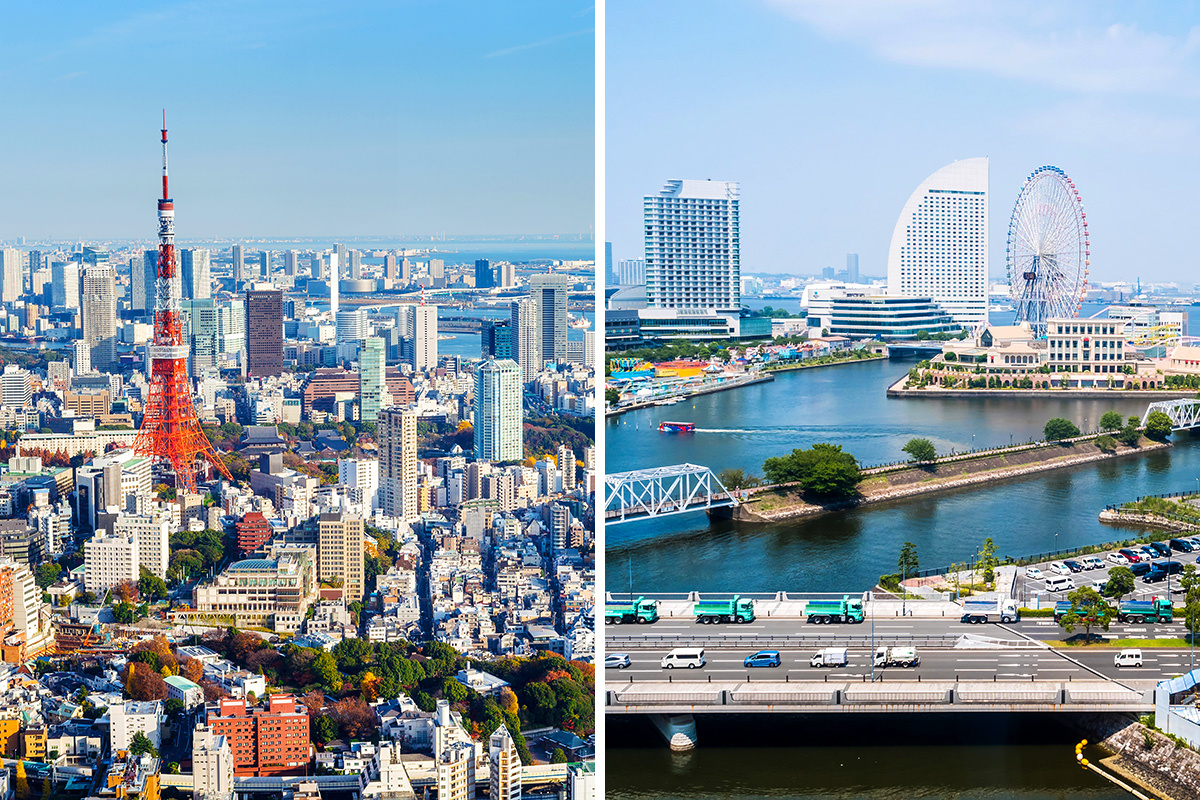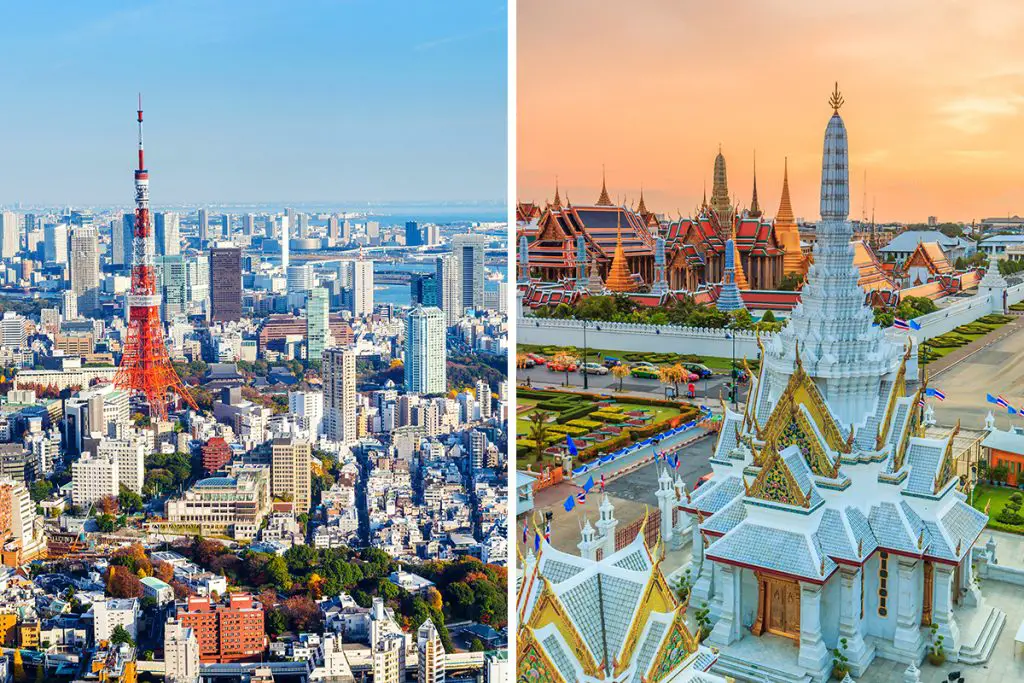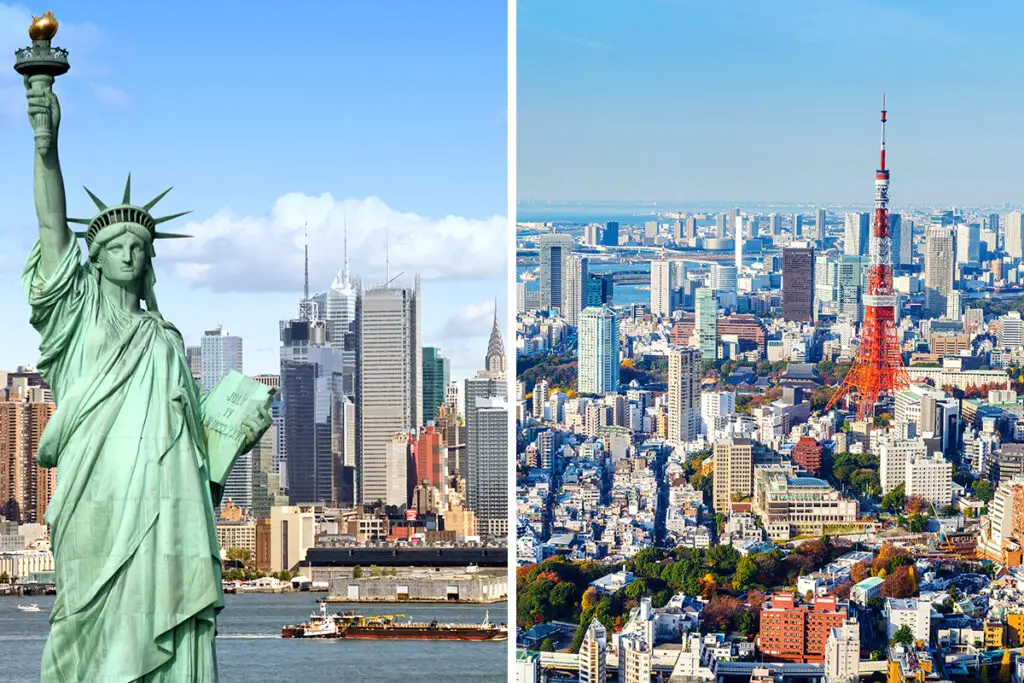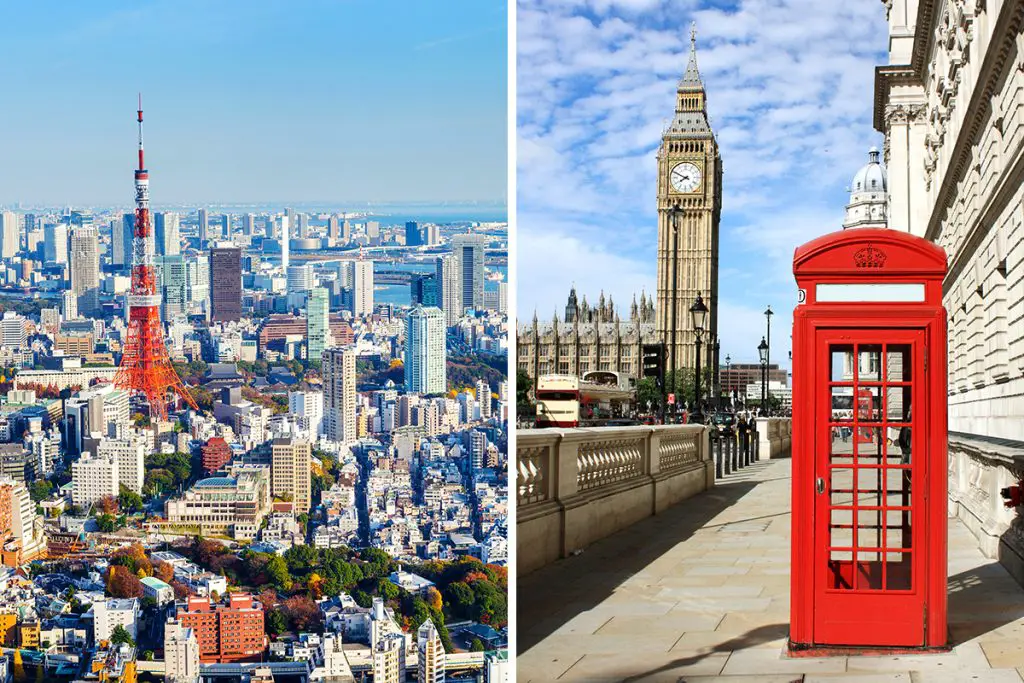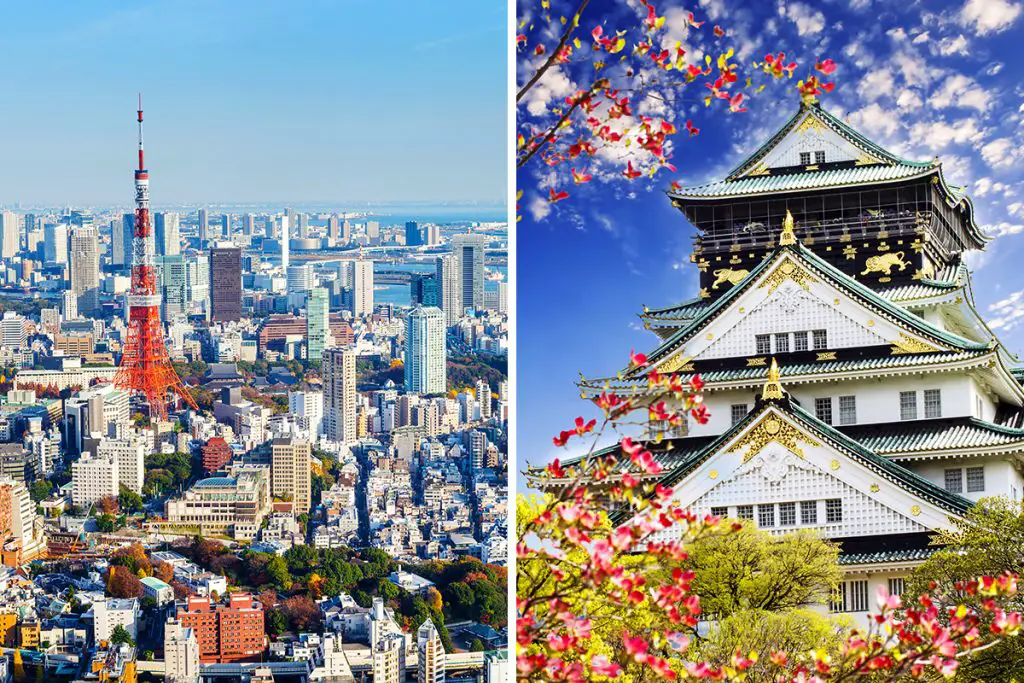If you’re anything like most travelers, you know that every destination has its unique allure. Tokyo and Yokohama are no different; each has a magnetic pull that appeals to different kinds of wanderers. The question that remains is, which city aligns more closely with what you’re searching for? Stick around, as we delve into various aspects that could help make your decision easier.
History & Culture
To start off, let’s sink our teeth into the rich history and culture of Tokyo and Yokohama. While you might think these cities are similar because they’re so close to each other—just about 30 kilometers (19 mi) apart—that’s far from the truth. Each has its own tale to tell and culture to share.
Tokyo is the epitome of Japan’s historical grandeur and modernity. It was formerly known as Edo and was the seat of power for the Tokugawa shogunate. This city has seen transformations that could fill textbooks.
From feudal battles to modern-day tech revolutions, Tokyo is a living museum. Picture this: On one street, you find yourself gazing at an ancient Shinto shrine, and on the next, you’re dwarfed by towering skyscrapers.
On the flip side, Yokohama was just a small fishing village until the mid-19th century. It became one of Japan’s major ports after Japan opened up to the world. Yokohama is a melting pot of cultures, thanks in part to its history as an international trading post. Unlike Tokyo, it has a more relaxed atmosphere, where different cultures and lifestyles coexist harmoniously.
Now, cultural diversity in Tokyo tends to blend into its fast-paced lifestyle. If Tokyo is like a seasoned orchestra playing a grand symphony, then Yokohama is more like a jazz band—cool, composed, and improvisational.
In Tokyo, you feel the immense weight of history and the rush of the future. Yokohama, however, lets you savor each moment, enriching your experience with layers of diverse cultural nuances.
So, in summary, Tokyo is your go-to if you’re captivated by a blend of ancient traditions and fast-paced modern life. Yokohama, on the other hand, invites you to take it slow and immerse yourself in a rich tapestry of diverse cultures. The choice between the two is like choosing between a roller coaster and a scenic Ferris wheel—both thrilling in their own ways, but offering completely different perspectives.
Attractions & Activities
Alright, let’s move on to something that’s likely at the top of your travel list: attractions and activities. You’re probably curious about how Tokyo and Yokohama differ in what they offer to feed your adventurous spirit. The experiences you’ll find in these two cities are as varied as they are enthralling.
In Tokyo, you can’t miss out on visiting the iconic Tokyo Tower. This 333-meter (1093 ft) tall structure offers panoramic views of the sprawling city below. There’s also the ancient Meiji Shrine, set in a tranquil forest where you can disconnect from the urban hustle for a while.
For a unique twist, head to Akihabara, Tokyo’s electric town, filled with anime, manga, and all things tech. The district is a geek’s paradise and represents a vibrant subculture within the city.
Now, let’s set our sights on Yokohama. Start your journey with a visit to the Sankeien Garden, a traditional Japanese garden that spans 175,000 square meters (43.24 acres). This scenic area provides you a quiet respite from city life, surrounded by lush flora and historical buildings.
Another must-see is the Landmark Tower, standing at 296.3 meters (972 feet). Take the elevator up to the Sky Garden 273 meters (896 feet) above ground and marvel at the endless horizon.
While Tokyo offers an experience steeped in both ancient tradition and futuristic endeavors, Yokohama provides a slightly different palette. In Yokohama, you could explore the Nippon Maru, a historic ship and maritime museum that celebrates the city’s connection to the sea.
Yokohama also offers the Osanbashi Pier, an architectural marvel where you can catch views of the magnificent bay area.
So, here’s the deal: If you’re into bustling energy, historical sites, and a touch of geek culture, Tokyo has got you covered. However, if you’re more into sprawling gardens, maritime history, and architectural wonders, Yokohama is your playground. Both cities offer unique experiences, which means you’ll have an unforgettable time no matter where you decide to go.
Beaches
Now, let’s talk about another facet of these cities that can seriously shape your experience—the beaches. You may be surprised at the difference a short distance can make when it comes to coastlines. Tokyo and Yokohama offer very different seaside experiences that can affect your overall vacation vibe.
In Tokyo, you have Odaiba Beach, located about 8 miles (approximately 12.9 kilometers) from the city center. It’s more of an artificial beach, created along the waterfront in Tokyo Bay. While swimming isn’t advised here, the scenic views and the walk along the beach are nothing short of relaxing. The area is a lovely spot for a romantic evening or a peaceful morning jog.
Switching over to Yokohama, there’s Zushi Beach, around 9.3 miles (roughly 15 kilometers) away from the city center. Zushi is a natural beach and offers a more authentic ocean experience compared to Odaiba. Here, you can indulge in water sports like kayaking and paddleboarding. Plus, the views are pretty fantastic as well.
Even though Tokyo and Yokohama are neighbors, their beaches serve up contrasting experiences. Odaiba Beach in Tokyo is perfect if you want a low-key, relaxed atmosphere without diving into water activities. On the other hand, Zushi Beach in Yokohama offers you the chance to be more adventurous, with its water sports and more natural setting.
In summary, if you’re yearning for a beach experience close to urban amenities, Tokyo’s Odaiba Beach could be just what you’re looking for. But if a natural beach and an active day on the water are more your style, Yokohama’s Zushi Beach would likely be the better choice for you.
Eating, Drinking & Nightlife
Ready to satisfy your taste buds and light up your nights? Let’s dig into the gastronomical and nocturnal playgrounds that Tokyo and Yokohama offer. These neighboring cities provide a treasure trove of experiences that appeal to your appetite and sense of fun.
In Tokyo, the food scene is an exciting mix of tradition and innovation. You can savor some of the world’s best sushi at Tsukiji Outer Market or head to the local izakayas in Shibuya for an array of Japanese tapas. Want a bowl of mouth-watering ramen? Shinjuku’s got you covered.
Now, let’s take a sip and talk about drinks. Tokyo offers an extensive range of options, from traditional sake bars to bustling izakayas and even high-end cocktail lounges like the New York Bar on the 52nd floor of the Park Hyatt Tokyo. If you’re in the mood for something unique, try chuhai, a fizzy, fruity alcoholic drink popular in the city.
Turning our attention to Yokohama, the food landscape here leans towards international flavors. In Yokohama’s Chinatown, you can sample authentic Chinese dim sum or Peking duck. For something closer to home, the Yokohama Red Brick Warehouse offers a range of Western-style restaurants.
On the drinking front in Yokohama, consider visiting craft beer pubs or waterfront bars with a view of the bay. The city also has a vibrant coffee culture, so if you’re not in the mood for alcohol, there’s always a comforting cup of joe waiting for you.
The nightlife in both cities differs too. Tokyo is famous for its lively districts like Roppongi and Shibuya, filled with clubs and bars that come alive when the sun sets. Yokohama, on the other hand, offers a more laid-back atmosphere with jazz bars and intimate live-music venues.
In summary, Tokyo is the place to be if you’re after a diverse range of food options, exquisite drinks, and an electrifying nightlife. Yokohama offers a more international food scene, a laid-back drinking culture, and a relaxed yet engaging nightlife. So, depending on what you’re after, both cities have something fabulous to offer.
Shopping
Wondering where you can unleash your inner shopaholic? Let’s delve into the retail paradises that Tokyo and Yokohama offer. Whether you’re a bargain hunter or a luxury aficionado, you’ll find a plethora of options in both cities.
Tokyo is the epitome of eclectic shopping experiences. Take Harajuku, for example. This district is a mecca for youth fashion and pop culture items. For high-end shopping, nothing beats the glitz and glamor of Ginza, where designer labels and opulent department stores abound. And if you’re a tech lover, Akihabara is a haven for electronics and gadgets.
Yokohama provides a somewhat different retail experience. Here, you can wander through the elegant Motomachi Shopping Street, known for its European-inspired fashion stores. If you’re into unique, artsy items, the Yokohama Red Brick Warehouse is a must-visit. This converted historical building hosts a selection of boutique shops that offer locally crafted goods.
While Tokyo offers a broad array of specialized districts for different shopping tastes, Yokohama takes a more curated approach. Here, you’ll find a mix of the traditional and the modern, but with a focus on unique and high-quality items.
In summary, if you’re looking for a wide variety of shopping experiences and don’t mind navigating through specialized districts, Tokyo is your playground. For those who prefer a more relaxed, curated shopping experience with a dash of local flavor, Yokohama is where you’ll want to be.
Accommodation
When you’re traveling, where you rest your head at night can make or break your trip. So, what can you expect in terms of accommodation in Tokyo and Yokohama? Each city has its own style and range of options, designed to suit various preferences and budgets.
In Tokyo, you’ve got an enormous array of choices. Love luxury? Hotels like the Imperial Hotel Tokyo and the Aman Tokyo offer top-notch amenities and stunning city views.
If you’re on a budget, capsule hotels like Nine Hours are not just economical but also a unique experience. And let’s not forget the numerous Airbnbs scattered across different neighborhoods, offering you a home away from home.
Yokohama’s accommodation scene is less overwhelming but still versatile. High-end hotels like the Yokohama Royal Park Hotel offer breathtaking views of the bay. If you prefer a more culturally immersive experience, Yokohama also has several traditional Japanese inns known as “ryokan,” where you can experience authentic Japanese hospitality.
The vibe differs between the two cities as well. Tokyo’s accommodations are often found amidst its busy, bustling streets, whereas Yokohama’s lodging options are generally located in more laid-back neighborhoods, offering a tranquil atmosphere after a long day of exploration.
In summary, Tokyo’s diverse and extensive accommodation options suit every kind of traveler, from luxury seekers to budget adventurers. Yokohama, on the other hand, offers a more relaxed ambiance, making it ideal for those looking to escape the hustle and bustle without compromising on comfort or quality.
Family-Friendliness & Children’s Activities
Taking a trip with the kiddos? It’s essential to know how family-friendly Tokyo and Yokohama are, and what activities are available for your youngsters. Each city caters to families in unique ways, ensuring you have plenty of options to keep everyone entertained.
Tokyo has multiple spots that kids will love. Ueno Zoo, for example, is home to a variety of animals, and nearby Ueno Park has paddle boats and open spaces to run around. Disneyland and DisneySea are also a short train ride away from central Tokyo, offering a magical experience for kids and adults alike.
Yokohama has its own set of attractions geared toward families. Hakkeijima Sea Paradise is an amusement park and aquarium rolled into one. The city also has the Anpanman Children’s Museum, where younger kids can interact with characters from the popular Japanese Anpanman series.
While both cities are packed with activities, Tokyo tends to offer more fast-paced, high-energy options. Yokohama provides a more relaxed atmosphere, making it a good fit for families who prefer a slower pace and more nature-oriented activities.
In summary, Tokyo offers a wide range of energetic activities and is generally more bustling, making it perfect for families who thrive in a lively environment. Yokohama, on the other hand, is ideal if you’re looking for a more peaceful family vacation with a focus on interactive and educational experiences.
Getting There & Getting Around
Transportation is a critical factor in any travel plan. How easy is it to get to Tokyo and Yokohama, and what about getting around once you’re there? Both cities are well-connected, but they offer different experiences in terms of travel and navigation.
For getting to Tokyo, you’ll likely land at Narita International Airport, about 37 miles (around 60 kilometers) away from the city center, or Haneda Airport, which is much closer at approximately 11 miles (about 18 kilometers) away. Yokohama doesn’t have its own international airport, but it’s just a 30-minute ride from Haneda.
Now, for getting around. Tokyo has a dense and complex public transportation network, including subways, buses, and taxis. You can get almost anywhere in the city and even beyond using your Suica or Pasmo prepaid card.
Yokohama’s public transport is less complicated. The city is served by local trains, subways, and buses, and you can use the same Suica or Pasmo card you’d use in Tokyo.
If you prefer driving, note that Tokyo’s roads can be congested, and parking is expensive. In contrast, Yokohama has slightly less traffic and more parking options, making it more driver-friendly.
In summary, both Tokyo and Yokohama are accessible and have efficient public transportation systems. However, Tokyo’s network is more extensive but complex, suitable for those who want to explore every nook and cranny. Yokohama is more straightforward, making it easier to navigate for those who prefer a more laid-back approach to travel.
Weather
Weather plays a big role in how much you’ll enjoy a trip. So, how do Tokyo and Yokohama stack up when it comes to climate? Both cities experience four distinct seasons, but there are some differences that might tilt the scale for you.
Tokyo tends to be hot and humid in the summer, with temperatures soaring up to around 95°F (35°C) in July and August. Winters are mild, but you can expect temperatures to drop to around 36°F (2°C) in January and February. If you’re keen on cherry blossoms, April is the month to visit. For colorful autumn leaves, November is your best bet.
Yokohama’s weather is quite similar but slightly more temperate. Summer temperatures rarely go above 89°F (32°C), making it a bit more bearable than Tokyo. Winters are a bit milder too, with lows of around 39°F (4°C). Cherry blossom season and fall foliage are also best enjoyed in April and November, respectively.
While both cities have a rainy season in June and July, Yokohama’s coastal location makes it slightly more susceptible to typhoons, especially between August and October. You’ll want to be prepared if you’re traveling during these months.
In summary, both Tokyo and Yokohama offer a full range of seasonal experiences. However, if you prefer slightly milder temperatures and are aware of the typhoon risk, Yokohama might be the better option for you.
Safety
When you travel, feeling safe is key to enjoying your trip. Tokyo and Yokohama both have reputations for being among the safest cities in the world, but there are some differences you should know about.
In Tokyo, crime rates are very low, especially violent crime. That being said, like any large city, it’s always wise to watch out for pickpockets in crowded places like Shibuya Crossing or on packed trains. Yokohama is similar in this regard, though being a smaller city, it has fewer areas where you’d need to be on high alert.
As for non-crime topics, earthquakes are a concern in both cities. Buildings in Tokyo and Yokohama are engineered to withstand earthquakes, and both cities have early warning systems and disaster preparedness measures in place.
Tokyo has a higher police presence, especially around major tourist areas, and you’ll find more police boxes called “Koban” on the streets. Yokohama also has these features, but they are less frequent.
In summary, both Tokyo and Yokohama are very safe cities with low crime rates and good infrastructure for dealing with natural disasters. The choice between the two would likely come down to personal preferences regarding the atmosphere and size of the city.
Cost
How much a trip will set you back is a crucial detail to consider. So, how do Tokyo and Yokohama compare in terms of expenses, specifically food, lodging, and transportation?
In Tokyo, the cost of living is generally higher. For example, a meal at a mid-range restaurant could cost around 2,000 yen (approximately 18 USD). Lodging varies widely, but a room in a three-star hotel typically starts at around 375 USD per night. As for transportation, a single subway ticket costs 170 yen (approximately 1.5 USD).
Yokohama is slightly more affordable. A similar meal might cost you about 1,800 yen (roughly 16 USD). Lodging costs are also a bit lower, with rooms in equivalent hotels starting at around 130 USD. Public transportation costs are about the same as in Tokyo.
In summary, while both cities can cater to various budgets, Yokohama tends to be a bit easier on the wallet. However, Tokyo offers a wider range of options, which might justify the extra expense for some travelers.
Which Is Better – Tokyo or Yokohama?
Deciding between Tokyo and Yokohama for your next trip involves a lot of factors. Both cities have their unique appeal, and what makes one a better choice over the other depends largely on what you’re looking to get out of your visit. Let’s break down the pros and cons of each based on what we’ve discussed in this guide.
When it comes to history and culture, Tokyo has a bit of an edge, offering a fast-paced urban experience steeped in both tradition and modernity. Yokohama is not far behind, especially if you prefer a laid-back, coastal vibe that’s rich in international influence.
If attractions and activities are your jam, Tokyo’s endless list of landmarks and sightseeing spots might make it the better option, whereas Yokohama provides a more relaxed pace with equally noteworthy places to visit.
Beach enthusiasts might find Yokohama more to their liking due to its scenic coastline, but Tokyo isn’t far from other beautiful beach destinations.
On the topic of food and drink, both cities offer a rich culinary landscape, but Tokyo has the edge if you’re looking for a more extensive selection of international cuisines and top-tier restaurants. Yokohama offers a more relaxed dining and bar-hopping experience, and may be easier on your wallet.
Shopping can be a tiebreaker for some, and Tokyo stands out with its wide array of options ranging from high-end boutiques to quirky pop-culture shops. Yokohama also offers excellent shopping but on a smaller scale. Accommodation varies in both cities to suit all budgets, with Tokyo offering more luxury options and Yokohama being generally more affordable.
Family-friendly activities abound in both cities. However, Tokyo’s larger size provides more options that can appeal to kids of all ages.
In terms of getting there and getting around, both cities are well-connected, but Tokyo offers more direct international flights and a more extensive public transportation network. However, if you dislike crowded spaces, Yokohama’s less busy streets and public transport may be a plus.
So, when should you choose one city over the other? Opt for Tokyo if you’re looking for a dynamic, bustling environment with more attractions, shopping options, and a wide range of international cuisines. Choose Yokohama if you prefer a more laid-back atmosphere, with beautiful beaches, fewer crowds, and a slightly lower cost of living. Ultimately, your personal preferences will be the determining factor in which city offers you the richer, more satisfying experience.

